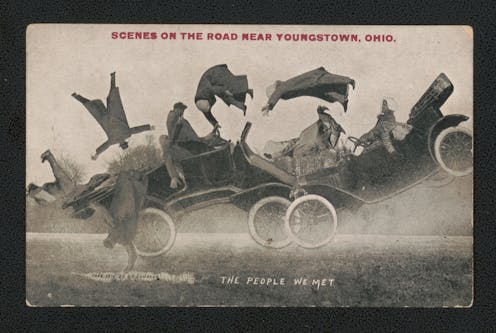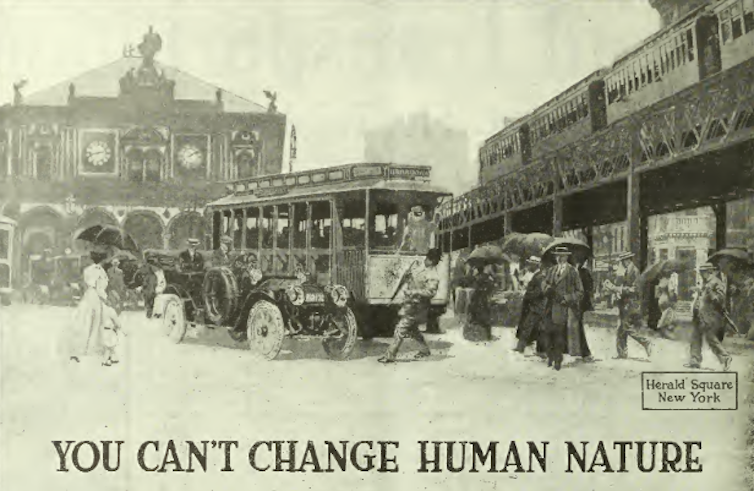Super Bowl car ads sell Americans the idea that new tech will protect them
Today it’s smart technology that will defend drivers and pedestrians. Over a century ago, it was the Klaxon horn.

Super Bowl ads tend to kick off trends, and it looks like the automotive industry will ramp up its pitch for electric vehicles after giving them center stage. Even Tesla, which has never run a Super Bowl ad, managed to sneak its Model Y into a Popeyes commercial, while Ram boasted that its new electric pickup truck’s smart technology solved the problems of “premature electrification” that left consumers unsatisfied.
But it was an ad paid for by the Dawn Project, a safety advocacy group, that will likely trigger a fleet of ads this year to reassure consumers that EV technology is safe.
In it, Tesla’s self-driving cars run down child-sized mannequins. Tesla CEO Elon Musk shrugged off the ad, tweeting that even bad publicity would end up promoting Tesla’s self-driving cars.
As a media scholar interested in how cultures deal with disruptive technology, I see similarities between today’s concerns over EVs and the early days of cars.
Back then, the public conversation usually contained a mix of optimism and fear. Then automakers turned to advertising to allay those fears.
Sound signals and safety
As it happens, advertising safer technology is as old as the automotive industry.
Because automobiles can endanger human life, engineers have long been trying to solve their safety problems. In the early 20th century, along with better brakes, headlights and steering wheels, engineers promised that advances in sound signaling technology – the car horn – would make driving safer by letting people know a car was coming.
In my new book, “Danger Sound Klaxon! The Horn That Changed History,” I tell the story of early sound signals. At first, engineers adapted the bells, gongs and whistles from other types of conveyances to automobiles. But eventually the industry settled on the squeeze bulb horn – the kind that makes a “honk honk” noise.
The only issue? In crowded streets, they weren’t loud enough to hear.
So in 1909, a new horn from the Lovell-McConnell company called the Klaxon solved that problem, promising drivers the ability, with just the touch of an electric button, to let loose a metallic “aaOOga” sound so loud that no one could miss it. They quickly set to work to convince the public that their patented noisy technology made driving safer.
Klaxon’s ad campaign used a new technique called “situational advertising” that put readers in imaginary situations where they were given a choice. Many of these ads, run in some of the era’s most popular magazines, asked readers to consider the best way to protect themselves from other people’s carelessness.
One Klaxon ad from a 1910 issue of the Saturday Evening Post portrays a distracted pedestrian stepping in front of a car in New York City’s Herald Square with the tag line “You Can’t Change Human Nature.”

“The auto must have a signal that really warns,” reads the copy. “If all minds were always alert – if children could protect themselves – if the weak were strong, there would be no need of any auto signal.”
And so the ad suggests that the only responsible solution for car owners is to own a Klaxon, because its distinctive noise said “AUTO COMING! LOOK OUT! NOW!”
Quieter tech to keep drivers safe
People bought the medium and the message. For two decades, Klaxon dominated the global car horn market and pumped its technocentric safety message into the media ecosystem.
But reliance on loud signaling technology to keep people safe became an odious proposition after the traumas of World War I, when Klaxons were used in the trenches as a gas alarm. In the postwar period, a transnational culture war against noise took off.
So societies everywhere turned to different forms of technology, like traffic lights, to solve the safety problem that noisy car horns could not. The Klaxon went into diminuendo as engineers turned their attention to the problems of quieting automobile noise with muffling technologies such as closed cabins and “silent gearwheels.”
Yet though their focus changed, the underlying message did not: Emerging technologies could always solve the problems caused by existing ones.
Smart technology promising less thinking
Flash forward to today and you can see that the more things change in technology advertising, the more they stay the same.
Consider a recent commercial for the Volkswagen Atlas that ran during football games all season – and which eerily echoes the Klaxon ad from 1910.
Titled “Those Guys,” the clever ad shows a wired-in zoomer, transfixed by his smartphone and oblivious to the world around him, walking the streets while Doris Day’s “It’s a Lovely Day Today” plays in the background. Like the man in the 1910 Klaxon ad, this guy steps right in front of a moving Atlas. But, thanks to its “Standard Front Assist and Pedestrian Monitoring” technology, the car brakes automatically and everyone is safe.
Obviously, the situation portrayed in the ad has changed. Today’s new quiet technology protects both pedestrian and driver from harm by sensing movement and automatically braking, so it doesn’t really matter whether either is warned.
But the subtext remains the same: Since you can’t change human nature and there will always be “those guys,” rest assured that emerging technology “built with safety in mind” can protect us.
And no matter what gadget the advertisers are trying to sell, that underlying technocentrism – a civic religion in American consumer culture that is practically as important as football – is a constant you can count on.
So whether it’s noisy horns, self-driving cars, smart speakers or cryptocurrency, people are bombarded with messages encouraging them to adopt new technology – without stopping to consider if they really need what companies are selling.
Matthew Jordan does not work for, consult, own shares in or receive funding from any company or organization that would benefit from this article, and has disclosed no relevant affiliations beyond their academic appointment.
Read These Next
From truce in the trenches to cocktails at the consulate: How Christmas diplomacy seeks to exploit s
World leaders like to talk up peace at Christmastime. But alongside the tales of seasonal breaks in…
As DOJ begins to release Epstein files, his many victims deserve more attention than the powerful me
Powerful men connected to Jeffrey Epstein are named, dissected and speculated about. The survivors,…
The world risks forgetting one of humanity’s greatest triumphs as polio nears global eradication − 7
Polio may finally be defeated in the next 5 years. Will the world recognize what an extraordinary achievement…






